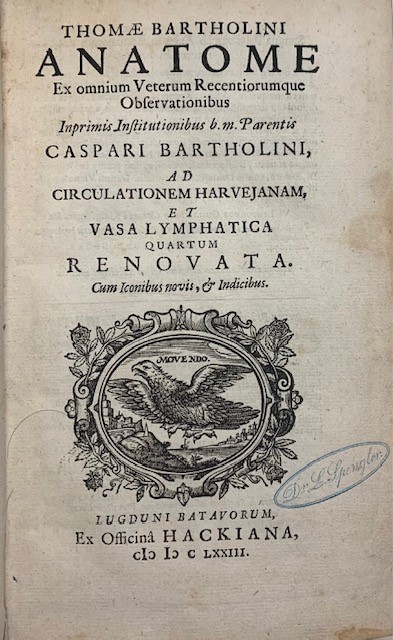
A newly acquired copy of “Anatome” by Thomas Bartholin is a welcome addition to the notable anatomy works in Falk Library’s Rare Book Collection. Published in Leyden in 1674, the library’s copy of the book is the de facto 4th edition of Bartholin’s Anatomy. It is Thomas’s revision of his father’s (Caspar Bartholin) anatomical work, which Thomas corrected, illustrated, and previously published in Leyden in 1641, 1645, and 1651.
Previously, Falk Library had only an imperfect copy of this work, with a missing title page replaced by a photocopy. However, recently we acquired the 4th edition from Dr. Osial. The newly donated copy is perfect. It has a typical 17th-Century vellum binding, title page in black and red font, multiple plates of illustrations, and two engravings by Gonsales Appelmans: Thomas Bartholin’s portrait and an allegorical scene of ancient anatomists surrounding and discussing a cadaver exposed on a stone table. The artist also included a reference to the modern anatomists by placing a portrait of Bartholin, framed between two palm branches above the observers, and a skeleton from Vesalius’ work, behind the group of anatomists. A notetaker is sitting below with Anatomia Bartholiniana inscribed next to him. Appelmans’ engraving is a tribute and homage to Bartholin’s contribution to anatomy.

Thomas Bartholin (1616-1680) came from a Danish family of famous scientists. Twelve Bartholins worked as professors at the University of Copenhagen. Four of them made significant contributions to anatomy: Thomas himself, his father Caspar (the Elder), his brother Rasmus, and his son Caspar (the Younger). Thomas was active as a mathematician, theologian, and doctor. He studied in Leyden, Paris, Montpellier, Padua, and Basel. From 1646, he worked at the University of Copenhagen, first as a professor of mathematics, then anatomist, and finally as a professor of medicine. He was also the King’s physician and worked as university librarian for a while.
Bartholin was a very prolific writer. According to P. Huard, he left 80 works behind. He is remembered in the history of medicine as discoverer of the lymphatic vessel system. He not only described lymphatics as anatomically and functionally separate from the veins but also proved that the liver was not an organ of blood formation, but of biliary secretion. He made an impact as a teacher who, whenever he presided over public dissections, always encouraged his audience to behave with dignity and respect for the deceased. During his studies, one of his teachers encouraged him to revise his father’s standard text on anatomy: “Anatomicae Institutiones Corporis Humani.” Thomas took this challenge, and the “Anatome” he created became one of the most important works in anatomy.
~Małgorzata Fort